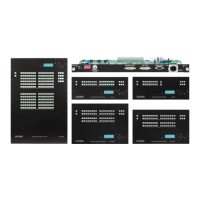4. Operation MX-FR Series Modular Matrix Frames – User's Manual 47
Unlocking an Output in Autotake Mode
Step 1. Press and release the required destination button that was previously locked.
source button, the Output Lock
button light up.
Step 2. Press and release the Output Lock button (deselection).
Now the Output Lock button turns off and the port has been unlocked. #unlock
The EDID Memory of a Matrix
The EDID memory is non-volatile and consists of four blocks, each for a different purpose. These blocks are:
▪ Factory preset EDIDs
▪ User saved EDIDs
▪ Dynamic EDIDs
▪ Emulated EDIDs
the number of the desired EDID. For example, F02 refers to the second factory preset EDID and D15 refers to
▪ F01..F99 .................Factory Preset EDIDs (not editable)
▪ U01..U50 ................User programmable memories
▪ D01..Dxx .................
▪ E01..Exx .................Emulated EDIDs (inputs)
All EDIDs (including factory preset; user programmable memories; EDID at other inputs; and EDID at outputs)
can be switched and emulated at any of the inputs.
ATTENTION!
memory even is the monitor is unconnected.
INFO: MX-CPU2 can handle both 128 Byte EDID and 256 Byte extended EDID structures.
EDID Types
Most of the factory preset EDIDs include only one resolution. This is to force the connected source to
give a signal with the needed resolution. However, there are Universal EDIDs as well, which allow many
resolutions. The factory EDIDs are divided into groups regarding their type. Some EDIDs are supporting DVI
only, some support HDMI, and some are for analog VGA signals. Also, there are some EDIDs for Dual Link
DVI resolutions. See the list of factory EDIDs in the Factory EDID List section.
DVI EDIDs do not support audio. The Universal DVI EDID indicates support for many PC (VESA) resolutions.
HDMI EDIDs support embedded audio. These EDIDs have PCM stereo audio format enabled. To allow other
audio formats like Dolby and DTS, special EDIDs have to be used. There are three Universal HDMI EDIDs that
include the same resolutions, but support different capabilities.
EDID PCM audio other audio deep color
Universal_HDMI_PCM yes no no
Universal_HDMI_ALL yes yes no
Universal_HDMI_DC yes yes yes
Analog EDIDs can be used for input ports that have a VGA (RGBHV) source.
Dual Link DVI EDIDs do not support audio. Use only for Dual Link ports.
Audio Options
feature. #audio
Supported Boards
▪ MX-TPS-IB-S, -A
▪ MX-HDMI-3D-IB-S, -A
▪ MX-TPS2-IB-SP, -AP
▪ MX-4TPS2-4HDMI-IB-A, -S
▪ MX-TPS-OB-S, -A
▪ MX-HDMI-3D-OB-S, -A
▪ MX-TPS2-OB-SP, -AP
Legend of the Figures
Audio de-embedder: Audio de-embedder is able to separate the HDMI video and audio.
Audio embedder: Audio embedder is able to add an audio stream to an HDMI video that does not contain
audio.
Interface and I/O switcher:
converts the analog input signals to digital and the digital output signals to analog.

